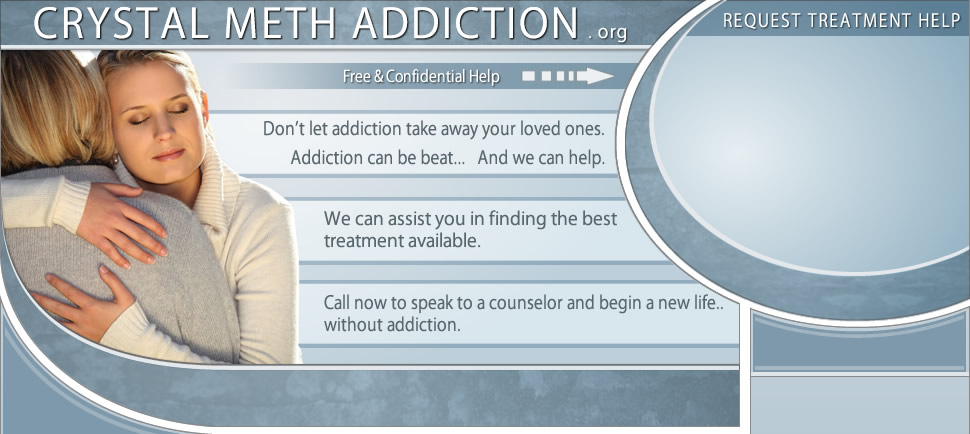Crystal Meth Help
Crystal Meth Effects and Symptoms
- Crystal Meth Effects
- Crystal Meth Withdrawal Symptoms
- Crystal Meth Symptoms
- Crystal Meth Side Effects
- Crystal Meth Overdose
- Injecting Meth
- Ingesting Meth
- Smoking Meth
- Meth and HIV
Crystal Meth Information
- Crystal Meth Addiction Treatment
- Crystal Meth Statistics
- Crystal Meth Facts
- Crystal Meth Prices
- Crystal Meth Street Names
- Crystal Meth Pictures
- Crystal Meth User Pictures
- Teen Meth Addiction
- Meth Addiction
- Drug Rehab for Meth Addiction
- Meth Intervention
Crystal Meth News
Meth and Pregnancy
Methamphetamine use among American females has been a serious problem for some time. A recent study has found that meth has become the most common reason for pregnant females to seek drug counseling. Meth use and pregnancy is a particular problem when one considers the risks involved, for both mother and child. When a women uses methamphetamine, she can experience a sense of euphoria, a rush of adrenaline, increased energy as well as a heightened sex drive. The use of meth intensifies a female's sexual desires to such a point, that she will forego good judgment and often engage in risky sexual behavior. This risky sexual behavior not only puts meth users at risk of transmitting sexually transmitted diseases, but many females meth users find themselves experiencing unwanted pregnancies. There are an estimated 16 million Americans who have tried meth at least one. Of these meth users, an estimated 19,000 are pregnant women. Almost 50% of females who admit to using meth while pregnant also admit to using alcohol.
According to one study, an infant who has been exposed just once prenatally to meth is at risk of experiencing long-lasting neurodevelopment difficulties. Infants who are born to females who used crystal meth while pregnant are also at a significantly high risk of experiencing other more serious health problems including being born prematurely, low weight at birth, heart defects, and other birth defects such as cleft lip or palate. These risks are evident even at a single low dose that has been taken during pregnancy. Among women of childbearing age, the use of meth is of particular concern due to how common abuse of the drug is and its long term effects on an unborn fetus.
Meth contains highly toxic and destructive chemicals and other ingredients that have been shown to cause cancer and other diseases which effect neurological development. Studies suggest that an unborn child cannot protect itself from the damage that meth can do to its DNA, as it doesn't have the ability to combat the free radicals contained in the drug. This vulnerability is evident throughout all trimesters of pregnancy, even after organs and other neurological and mental functions have developed. As a result, infants who are born to meth using mothers show brain abnormalities that are worse than infants who have been prenatally exposed to alcohol. These adverse effects, as a result of prenatal exposure to meth, have been found to cause learning and behavioral problems in these children. The combination of both meth and alcohol exposure prenatally may actually result in even more severe and long-lasting damage.
Specifically, the part of the brain known as the caudate nucleus, which plays a role in learning and memory, motor control, and motivation, is one of the areas of the brain which is most affected by prenatal exposure to meth. A scientific team set out to study the specific effects of prenatal meth-exposure compared brain scans of 61 children, 21 of whom had been prenatally exposed to be with meth and alcohol, 13 of whom had only been exposed to alcohol, and 27 unexposed. This study, which was conducted utilizing MRI technology, showed definite changes in the size and structure of certain areas of the brain in children who were prenatally exposed to meth. Prior to this study, previous studies had already concluded that brain structures of meth exposed children were similar to that of children who had been exposed to alcohol in the womb, some of which were even smaller than those who had been exposed to alcohol.
Meth use and pregnancy is not only a danger for the unborn fetus, but also puts the mother at risk of life-threatening pregnancy complications. Research has shown that of common complications, such as uncontrolled high blood pressure, pregnant meth addicts are at a significantly higher risk than non-users. One study at a Phoenix hospital over a 6 year period compared 276 female meth users who gave birth to 34,055 females who gave birth at the same hospital during the same time frame but were not meth users. The meth users who were part of the study had either admitted to use of the drug or had tested positive for it. While the study was underway, the number of pregnant meth mothers that were identified rose steadily from 22 in 2001, to 43 in 2004, to 77 in 2005.
On just about every measure examined in the above study, pregnant meth users and their babies fared far worse than mothers who were not meth users. About 50% of the meth mothers delivered premature babies, as compared to 17% of the non-meth using mothers studied. About 29% of the meth using mothers required a C-section, while only 23% on the non-meth using control group required such a procedure. Nearly 20% of the meth using mothers suffered from uncontrolled high blood pressure and another 10% experienced placental abruption, a condition which causes the placenta to separate from the uterus prior to delivery.
Women who are using meth while pregnant often don't take proper care of themselves or take precautions and measures to ensure a safe and healthy pregnancy. The above study is evidence of this, with over two-thirds of the meth using pregnant women studied reporting less than five prenatal care visits. When born, 6% of babies born from the meth using mothers had low Apgar scores, a test designed to measure newborn health, as opposed to only 1% of babies born to the non meth using mothers studied. Four percent of the infants whose mothers had used meth while pregnant died soon after delivery, as opposed to only 1% of the babies born from non-using mothers. The study also found that almost 25% of the meth using pregnant females studied had been victims of domestic abuse while pregnant, and 40% had their babies taken away from them to either be placed in foster care, be put up for adoption or placed in the care of someone else if only temporarily.

